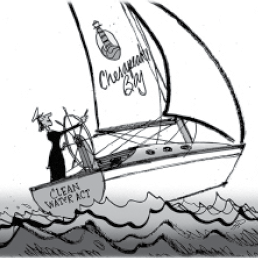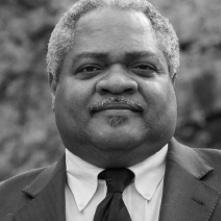The challeneges of the biggest watershed restoration project in the country’s history are testing the limits of the Clean Water Act. The law’s “pollution diet” for the Chesapeake Bay, issued by EPA in 2010, serves as the basis of a ground-breaking multi-state experiment in cooperative federalism. The CWA tool is known by the abbreviation TMDL, for Total Maximum Daily Load of pollutants. The term has emerged front and center in reducing the contaminants that continue to enter the Chesapeake from countless individual sources in a watershed spanning 64,000 square miles. Mixed recent progress reports make us ask what needs fixing at the same time that some successes suggest measures that warrant replication in other regions.
For non-CWA buffs, a TMDL is the highest amount of a pollutant that can be discharged daily into a waterbody — critically, from all sources combined — and still meet water quality standards. A water quality standard has two components: a designated use (such as swimming or trout habitat) and the maximum ambient concentration of any pollutant that still allows the use to be achieved. A TMDL is calculated such that it can’t be exceeded without bad water quality results.
The Chesapeake Bay is the biggest estuary in the country. It is a multi-billion-dollar driver of the mid-Atlantic economy, including commercial and recreational fishing, shipping, tourism, and the many businesses that support them. Its watershed covers parts of six states — New York, Pennsylvania, Virginia, West Virginia, Maryland, and Delaware — plus the District of Columbia. It is home to 18 million people, plus over 3,500 species of plants, fish, and other animals. It is famous for its blue crabs, oysters, skipjack sailboats, and rich cultural history based on the bay’s bounty and abundance. However, several centuries of land development, deforestation, and industrialization have resulted in serious pollution of the bay and its tributaries. Nitrogen, phosphorus, and sediment runoff, mainly from farms and contaminated urban and suburban stormwater, have caused widespread exceedance of water quality standards for dissolved oxygen, chlorophyll-a (an indicator of algae levels), and water clarity. All of these are vital to the survival of fish, shellfish, and countless aquatic organisms up and down the food chain. As a result, the oyster population is at one percent of its historic level. Blue crabs and striped bass are also far below their levels in a healthy Chesapeake.
To reverse the damage, the bay jurisdictions began in 1983 to coordinate efforts to reduce pollution entering the estuary. They formed the Chesapeake Bay Program, with a staff in Annapolis. In 1987 Congress codified this arrangement in a new Section 117 of the CWA, which provided funding to achieve the desired water quality goals. However, after 24 years it became clear that the state-by-state approach was not working. Among other things, there was no mechanism for interstate enforcement. Virginia and Maryland had no authority to require farmers in Pennsylvania to curtail polluted runoff into the Susquehanna River, which accounts for half the freshwater flow into the bay.
In 2007 the states asked EPA to develop an interstate TMDL that would determine the amounts of nitrogen, phosphorus, and sediment that the bay could tolerate and still meet water quality standards. EPA would then allocate the allowable loadings among the states based on their contribution volumes, and further allocate them among major river basins to help the states in the planning process. This would enable each state to calculate how much it needed to reduce its discharges of each pollutant to reach the allowable levels. EPA proceeded to develop this biggest-ever TMDL, in consultation with the states, numerous technical experts, and the public.
The process got a boost in 2009 when President Obama issued an executive order declaring the Chesapeake a “national treasure” and proposing to “protect and restore the health, heritage, natural resources. and social and economic value of the nation’s largest estuarine ecosystem and the natural sustainability of its watershed.” It directed EPA and six other federal agencies to work with the states, local communities, and the private sector to develop a strategy to achieve these goals, including milestones, transparency, and stakeholder outreach and accountability.
At this point, let’s take a quick look at the history of EPA’s use of TMDLs. What we call the Clean Water Act today had legal predecessors. When Congress passed the far-reaching Federal Water Pollution Control Amendments in 1972, it preserved in Section 303 the states’ role to set water quality standards. If a state fails to do so, or EPA finds them inadequate, the federal agency can set them. States must maintain a list of all waters not meeting water quality standards (“impaired waters”), which must be submitted to EPA in even-numbered years. For all pollutant-impaired waters the state must develop TMDLs. If a state fails to do so, or if EPA finds the offering inadequate, EPA develops the TMDL and the state must include it in its water quality planning process. While EPA periodically reviews a state’s planning process for consistency with the act, the federal government may not step in and write the plan itself. What if a state fails to implement a TMDL? EPA has no authority to enforce it.
For a dozen years after enactment of what we came to call the Clean Water Act, EPA largely ignored the use of TMDLs. Then, starting in the mid-1980s, environmental groups began suing the agency and the states for failure to adopt them. Courts frequently put the agencies under consent orders to move forward, and soon TMDLs were being developed for impaired waters across the country. However, a Government Accountability Office report issued in December 2013 found that although by then some 50,000 TMDLs had been issued, often little was being done to implement them or prioritize the more needy waters.
In that same month, EPA issued “A Long-Term Vision for Assessment, Restoration, and Protection Under the Clean Water Act Section 303(d) Program.” This plan called on states to engage the public and prioritize their impaired waters. It promoted integrating the CWA’s planning and funding programs and the resources of other agencies (such as the Agriculture Department’s farmland conservation programs) to do a more effective job.
This followed a March 16, 2011, memorandum from EPA’s assistant administrator for water to the regional administrators on “Working in Partnership With States to Address Phosphorus and Nitrogen Pollution Through Use of a Framework for State Nutrient Reductions.” It stated: “Over the last 50 years. . . the amount of nitrogen and phosphorus pollution entering our waters has escalated dramatically,” producing a “degradation of drinking and environmental water quality.” Citing agricultural practices and stormwater runoff as among the main causes, the memorandum stated prophetically: “Nitrogen and phosphorus pollution has the potential to become one of the costliest and most challenging environmental problems we face.” That problem was already apparent in the Chesapeake.
When the federal environmental agency developed the Chesapeake Bay TMDL, it set annual allowable loadings of 185.9 million pounds of nitrogen, 12.5 million pounds of phosphorus, and 6.5 billion pounds of sediment. To achieve these caps required a 25 percent reduction of nitrogen, a 24 percent reduction of phosphorus, and a 20 percent reduction of sediment loadings. This would be especially challenging because the two biggest sources of all three pollutants are farm runoff, carrying nutrient-laden manure and pesticides, and contaminated urban and suburban stormwater runoff. With minor exceptions these are nonpoint sources, and as such are not subject to regulation by EPA under the CWA. Instead, regulation of these sources is left to the various authorities held by states, and that regulation is spotty.
Given the extraordinary magnitude of the task, the TMDL included a novel “accountability framework” consisting of four main components. First, by 2017 the states were to have in place all the measures needed to achieve 60 percent of the required reductions, and by 2025 they need to have in place 100 percent of the needed measures. Second, each state was to develop a Watershed Implementation Plan, or WIP, describing in detail all the measures that will be taken to achieve the necessary pollution reductions with “reasonable assurance,” including permits, regulations, and other measures, along with the financial and personnel resources and legal authority to implement the measures. This requirement is based on the Section 303(e)’s “continuing planning process,” referred to above, and the resulting plan designed to achieve compliance with water quality standards and TMDLs. It is also supported by Section 117(g), applicable specifically to the Chesapeake Bay Program, requiring the development and implementation of “management plans” for pollution reduction.
The third component of the accountability framework was the use of two-year “milestones” and annual progress reports to ensure that each state is making reasonable progress toward the water quality goals. While this mechanism is not mentioned in the statute, EPA relied in part on Section 303(d)’s requirement that a TMDL “be established at a level necessary to implement the applicable water quality standards” and the broad goal in Section 101(a) “to restore and maintain the chemical, physical, and biological integrity of the nation’s waters.” Every two years, each state publishes for public comment and EPA review its proposed measures for the coming two years, as well as its assessment of what it has accomplished during the previous two years.
The fourth component, in the absence of enforcement authority, is EPA’s use of “backstop” measures when a state either submits an inadequate WIP or fails to make reasonable progress on its milestones. These include expanding permit coverage under the federal water law’s National Pollutant Discharge Elimination System to point sources not currently covered, requiring additional reductions of nutrients or sediment from existing point sources, requiring greater offsets for new or expanded discharges, increasing federal inspections and enforcement, and conditioning or redirecting grant funds. EPA’s commitment to act as the referee to make sure that each state does its fair share was an essential component of the accountability framework. During the first six years of implementation, EPA imposed backstops where state WIP or milestone provisions, or actual progress, were inadequate. During the Trump years, EPA did not play this essential role, which, among other things, allowed Pennsylvania to fall far behind.
Various aspects of the TMDL, including the accountability framework, were challenged in court by agricultural and construction industry groups as exceeding EPA’s statutory authority. But those challenges were all rejected in 2015 by the Third Circuit in American Farm Bureau Federation v. EPA, and the Supreme Court denied certiorari a few months later.
In an article in the January/February 2016 issue of this journal, I discussed the initial implementation of the TMDL, the important issues resolved in the litigation, and the widespread cooperation among federal, state, and local stakeholders, including the NGO community and the private sector. This has been matched by the cooperative work done via the Chesapeake Bay Program Partnership by governors, agency heads, program staff, and the scientific community. I described the Chesapeake Watershed Agreement executed in 2014 by the governors of the bay states, the DC mayor, the Chesapeake Bay Commission (a unique body representing the legislatures of Pennsylvania, Virginia, and Maryland) and EPA, recommitting to the goals of the TMDL and to the broader objectives of the executive order. These include habitat and wetland restoration, species protection, and environmental education. I also identified some challenges: funding shortfalls, a shortage of technically skilled personnel, and difficulties in verifying that pollution control measures were actually improving water quality.
In the five years since then these problems have persisted, aggravated by lax regulatory enforcement. In addition, the program is facing new challenges that were not fully appreciated then. These include the significant adverse effects of climate change; the unexpected addition of six million pounds of nitrogen because the Conowingo Dam, on the Susquehanna River, used up its sediment storage capacity; the failure of Pennsylvania to adequately fund its WIP; the failure of EPA for four years to act as an effective referee; and constraints on field work caused by Covid.
DESPITE enormous efforts during the past decade, the health of the bay is a mixed picture. According to the Chesapeake Bay Foundation’s widely respected 2020 “State of the Bay Report,” water quality is improving, though at a slower pace than will be needed to meet the 2025 goals. The states are relying heavily on farmers to achieve major reductions of nitrogen runoff, but this is based mainly on voluntary action and substantial public funding. Blue crab and oyster populations are showing modest improvement. The 2025 target for total acres of bay grasses, which provide critical habitat for juvenile fish and birds and are an important gauge of progress, is 130,000 acres. By 2018 the figure stood at a 30-year high of 108,000 acres, but two seasons of heavier than usual rains, attributed to climate change, reduced that figure to 66,387. The 2025 goal for restored wetlands is 85,000 acres, but only 16,000 have been added since 2014.
Pennsylvania is responsible for 40 percent of the nitrogen, 24 percent of the phosphorus, and 31 percent of the sediment entering the bay. It is far behind the other states in nitrogen reduction, and in 2019 submitted to EPA a Phase 3 WIP (covering the period from the 2017 midpoint assessment through 2025) which on its face will not achieve the 2025 goals. It also shows an annual funding shortfall of $324 million, with no fresh source of funding in sight. The state’s failure to provide the needed funds reflects the fact that a majority of its legislators are not from the Chesapeake watershed (almost entirely the Susquehanna River watershed), and many complain that they get much less enjoyment from the Chesapeake Bay than do Marylanders or Virginians. This overlooks the fact that the state’s failure to clean up the Susquehanna is not just causing problems in downstream waters, but has major adverse impacts on Pennsylvania’s own drinking water supplies and recreational and commercial activities.
After EPA approved Pennsylvania’s WIP in 2019 and failed to apply backstops, the attorneys general of Maryland, Virginia, Delaware, and the District of Columbia sued the federal agency based on EPA’s “nondiscretionary duty” under Section 117(g) to “ensure that management plans are developed and implementation is begun . . . to achieve and maintain . . . the [prescribed] nutrient goals . . . for the quantity of nitrogen and phosphorus entering the Chesapeake Bay and its watershed.” The suit alleges that the agency’s approval of the defective WIP violated this duty. A similar allegation was made concerning EPA’s approval of New York’s facially inadequate WIP. New York has since tried to cure its defects. The Chesapeake Bay Foundation filed a similar suit. Fortunately this litigation does not appear to have dampened the states’ commitments to the restoration goals or the partnership process.
What will the new administration do? EPA’s Michael Regan has pledged strong support for the bay restoration. Whether this results in backstops or other measures remains to be seen. As of this writing we are awaiting appointment of an administrator for Region 3, where the bay program is housed. In any case, Pennsylvania’s shortfall will pose a big challenge for the partnership going forward.
Meanwhile the effects of climate change in the watershed are now far more apparent than they were 10 years ago. Sea-level rise is already affecting many low-lying communities, routinely flooding large areas and destroying wetlands. Heavier spring rains during the past three years have washed larger quantities of contaminated soil into the bay and its tributaries. In addition to the devastating effects on fragile bay grasses noted above, it is estimated that this “new normal” level of precipitation will annually bring five million more pounds of nitrogen into bay waters. Each state WIP now has provisions to deal with climate change, and to build resiliency into its land use planning. Priority will increasingly go to measures that both reduce nutrient and sediment runoff and sequester carbon dioxide, such as streamside vegetated buffers, wetland restoration, and urban tree canopy.
In addition, the Conowingo hydroelectric dam, located on the Susquehanna River in Maryland just below the Pennsylvania border, has for many decades trapped large quantities of sediment behind it. This trapping capacity has been exceeded, resulting in an additional 6 million pounds of nitrogen and 260,000 pounds of phosphorus flowing into the bay annually. By coincidence in 2014 the 50-year license of the operator, Exelon, came up for renewal before the Federal Energy Regulatory Commission. There was hope that Maryland would use its CWA Section 401 authority to require Exelon to contribute major funding to reduce this pollution and thereby protect downstream water quality, but that fell through when Maryland settled for a contribution that was viewed by many as way too cheap. The license is being challenged in the D.C. Circuit.
There was no plan to deal with this additional pollution. Because the states had no extra funds, and cost allocation will be contentious, they decided to develop a new Conowingo WIP with long-term funding. To my knowledge, this is the first interstate WIP in the country, and something not contemplated by the CWA. Instead of becoming part of a state’s “continuing planning process,” this plan will be supervised by the Bay Program Partnership. Specifically, this will be the Principals’ Staff Committee, which consists of all the state agency heads, reporting to the governors. The states anticipate selecting an interstate entity to manage the activities and the finances, such as the Susquehanna River Basin Commission, but the financing has yet to be identified.
What have we learned from all this? First, a multi-state TMDL is the only Clean Water Act tool available to address interstate pollution. It has provided a highly effective framework, enabling the states to secure an allocation of the watershed-wide loadings for three major pollutants. Given the increasing recognition of the effectiveness of watershed-wide approaches to water quality restoration, this is a valuable lesson. Second, the pathbreaking level of detail in the WIPs provides useful models for other watersheds. Third, the accountability framework has been essential not only in keeping the states moving forward, but in providing each state with the needed assurance that the others are doing their fair share.
The failure of Pennsylvania to lift its part of the burden is as much the failure of EPA oversight as it is the failure of the legislature in Harrisburg to provide the funds. It also highlights EPA’s inability to actually enforce a TMDL, which is a shortcoming in the statute. While Section 117 gave EPA a bit more authority to require WIPs than Section 303(e) alone, since such plans are required by Section 303(e) and this accountability framework was upheld based on that section by the Third Circuit, this framework is available for use elsewhere.
Fourth, establishment of the Chesapeake Bay Program office, with a permanent staff of scientists and managers, has been vital to the provision of technical support and the performance of tasks one time for all seven jurisdictions. Fifth, the Chesapeake Watershed Agreement of 2014, by recommitting all the parties to the TMDL and the broader watershed restoration objectives of the executive order, facilitated the establishment of specific goals and outcomes, with activities managed by committees and work groups drawing from all of the bay states under the oversight of the Principals’ Staff Committee.
Sixth, the process has demonstrated that cooperative federalism — which in this case involves federal, state, county, and local governments, universities, NGOs, and private individuals — can succeed. This was energized by a commitment to collaboration, outreach, and good communications.
In the scientific area, the use of modeling to predict environmental outcomes has been refined and applied in multiple contexts. These include the setting of the TMDL itself, using a series of interconnected bay watershed models, and the ability to predict what the likely reductions in pounds per year of nitrogen, phosphorus, and sediment will be from the application of any of some 200 different Best Management Practices on any given piece of property. Studies have also confirmed that the most cost-effective reductions of these pollutants occur on farms. Since Department of Agriculture cost-share programs have often not been adequate, this has stimulated state legislation to provide incentives for farmers to install the needed measures, including outright purchase of the pollution reductions. The only sector that has been losing ground is stormwater, both uncontrolled runoff and areas covered by MS4 permits. Here experience shows a need for more green infrastructure and stronger enforcement.
Barring a miracle in Pennsylvania, the bay states will not meet their 2025 water quality goals on time. Other significant challenges include climate change, financing the Conowingo WIP, the perennial shortfall in program funding and technical support, and the need for strong federal oversight. However those issues are dealt with, we have learned a lot from the Chesapeake Bay restoration so far. Given the widespread determination to succeed, there is good reason to believe that the water quality and the overall health of the watershed will continue to improve. It is exciting to see people rising to the challenge. TEF





